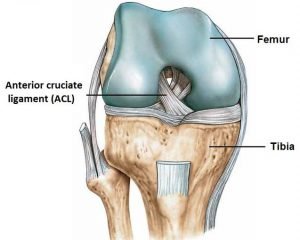
ACL Injuries: Surgical Reconstruction versus Conservative Rehabilitation
ACL Injuries: Surgical Reconstruction versus Conservative Rehabilitation

What is the ACL?
The ACL is one of two ligaments inside the knee joint, which prevent excessive movement between the femur and tibia. The ACL can rupture when subjected to excessive forces, especially rotational and shear forces. It is important to understand that the ACL does not function in isolation to restrain excessive movement of the knee. Adequate muscle strength and balance are equally importing in preventing injury.
Surgical Reconstruction of the ACL
The ACL has no capacity to heal if it is ruptured. Historically surgical reconstruction using either a strip of the patella or hamstring tendon has been performed. This type of surgery is followed by an average of 9-12 months of physio rehab before return to sport. Other options include the use of synthetic ligaments, which allow a faster return to sport but involve a higher risk of re-injury.
Conservative Rehab for ACL Injuries
Conservative rehab involves guided strength, flexibility, balance and proprioception training with a knee physio. The extent of conservative rehab depends on the individual’s goals and motivation. It has long been reserved for those that lead a relatively sedentary lifestyle who are not interested in playing sport or performing twisting and pivoting movements. Young, athletic populations are usually persuaded to have surgery. Those that have surgery will still require extensive rehab afterwards.
Recent Evidence for Surgery versus Conservative Rehab for ACL Injuries
The recent Winter Olympics provided an opportunity to witness a number of athletes competing at the highest level without an ACL. Some of these athletes had failed reconstructions in the past and decided not to pursue that option again, some had recently ruptured their ACL and didn’t have sufficient time to recover from surgery and one was simply born without an ACL.
This raises the question of whether surgical reconstruction is necessary following an ACL rupture. Perhaps the 9-12 months of physio rehab following surgery is more important than the surgery itself.
Unfortunately there is limited evidence comparing the outcomes of surgery versus conservative rehab for ACL injuries. One research paper found that outcomes were fairly similar between the two groups, however a number of participants in the conservative group continued to report instability and later went on to have surgery.
Take Home Message
It is possible to avoid surgery following an ACL injury. Physiotherapy rehab for ACL injuries has improved significantly over the years and a growing number of athletes have successfully returned to high level sport without symptoms. However, a number of athletes who trial conservative rehab will continue to have instability and will require surgical reconstruction. If there is no deadline for return to sport, attempting conservative rehab before considering surgery may be a sensible approach.
Come and visit the experts at our Duncraig Physio clinic to discuss the optimal management plan for your ACL injury.